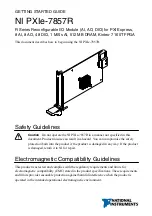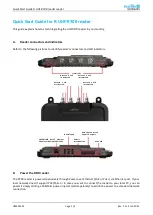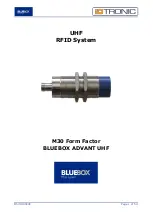
KTI63421 4 05/01/19
4. Attach the crane's hook to the balancer, leveler, sling, chain or any combination thereof. Turn the release valve on the crane's
hydraulic ram in a clockwise direction until tight. Before pumping the crane's jack handle, make sure the engine or load is free from
all other restraints and connections that would hinder the raising of the load. Once the engine or load has cleared its location, make
sure there is no slope in the floor or any obstructions on the floor that could cause the crane to tip and lose the load.
5. Immediately upon removal of the engine from the engine compartment or load from its position, the engine or load must be as close
to the ground as possible when transporting. Lower the load to the proper transport height by slowly and carefully turning the
hydraulic ram's release valve in a counter clockwise direction. When approaching the transport height, start turning the crane's
release valve in a clockwise direction until tight. This same procedure of lowering the load is also used for moving a load to its final
or temporary resting place or location. This crane is equipped with a load restraint system identified as (#31) sliding strap loop
(2 each) and (#32) strap tie down (2 each). Before transporting the engine:
a. Determine an attachment position on both sides of the engine.
b. Slide the sliding strap loops on the crane's legs so the loops are aligned with and adjacent to the attachment positions on
both sides of the engine.
c. Connect one hook at the end of the strap tie down to the sliding strap loop and the hook at the other end of the tie down to
the attachment position on the side of the engine. Do this on both sides of the engine.
d. Adjust the strap tie downs to take up the slack but not enough to force the engine towards one leg more than the other.
e. Tighten tie downs equally so the engine will not swing side to side during transport of the engine.
PREVENTATIVE MAINTENANCE
This is the safety alert symbol used for the PREVENTATIVE MAINTENANCE section of this manual to alert you to
potential personal injury hazards. Obey all instructions to avoid possible injury or death.
1. Always store the crane in a well protected area where it will not be exposed to inclement weather, corrosive vapors, abrasive, dust, or
any other harmful elements. The crane must be cleaned of water, snow, sand, grit, oil, grease or other foreign matter before using.
2. Lubricate the wheels, casters, and all pivot points on the crane according to an acceptable shop maintenance schedule.
Maintenance intervals are dependant on time and usage.
3. Every crane owner is responsible for keeping the crane labels clean and readable. Use a mild soap solution to wash external
surfaces of the crane but not any moving hydraulic components. Contact K-Tool International for a replacement label if your crane's
label is not readable.
4. Inspect the crane before each use. Do not use the crane if any component is cracked, broken or bent. Do not use the crane if it
has loose or missing hardware or components, or is modified in any way. Take corrective action before using the crane again.
5. It should not be necessary to refill or top off the crane’s jack reservoir with hydraulic fluid unless there is an external leak. An
external leak requires immediate repair which must be performed in a dirt-free environment by qualified hydraulic repair personnel
who are familiar with this equipment. Authorized service centers are recommended.
IMPORTANT:
In order to prevent seal damage
and jack failure, never use alcohol, hydraulic brake fluid or transmission oil in the jack. Use hydraulic jack oil, a light turbine oil,
Chevron AW ISO 32 or Unocal Unax AW 150.
TROUBLESHOOTING
PROBLEM: CRANE WILL NOT LIFT RATED LOAD.
POSSIBLE CAUSE:
Release valve not tightly closed.
ACTION:
Close release valve firmly.
POSSIBLE CAUSE:
Overload condition.
ACTION:
Use crane with proper capacity.
POSSIBLE CAUSE:
Air trapped in hydraulic system.
ACTION:
Purge air from system by following steps "a" though "d" in the "SETUP INSTRUCTIONS" section of the manual.
POSSIBLE CAUSE:
Hydraulic valves not operating properly.
ACTION:
Contact your dealer.
PROBLEM: CRANE WILL LIFT BUT LOWERS RATED LOAD SLOWLY.
POSSIBLE CAUSE:
Release valve not tightly closed.
ACTION:
Close release valve firmly.
POSSIBLE CAUSE:
Hydraulic valve not tightly closed.
ACTION:
Contact your dealer.
PROBLEM: CRANE WILL NOT LOWER AFTER RATED LOAD HAS BEEN REMOVED.
POSSIBLE CAUSE:
Jack's reservoir has too much fluid.
ACTION:
Place jack in its upright position. Retract the ram. Remove the reservoir fill plug. Allow oil to drain out of fill plug until oil level
is at bottom level of hole. Reinstall fill plug.




































